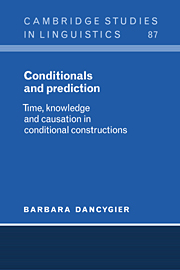Book contents
- Frontmatter
- Contents
- Acknowledgments
- 1 Conditionals as a category
- 2 Prediction and distance: time and modality in conditional clauses
- 3 Relations between the clauses in conditional constructions
- 4 Knowledge and conditional protases
- 5 Conditional clauses: form and order
- 6 If and other conditional conjunctions
- 7 Conclusion: prototypical conditionality and related constructions
- Bibliography
- Index of names
- Subject index
5 - Conditional clauses: form and order
Published online by Cambridge University Press: 22 September 2009
- Frontmatter
- Contents
- Acknowledgments
- 1 Conditionals as a category
- 2 Prediction and distance: time and modality in conditional clauses
- 3 Relations between the clauses in conditional constructions
- 4 Knowledge and conditional protases
- 5 Conditional clauses: form and order
- 6 If and other conditional conjunctions
- 7 Conclusion: prototypical conditionality and related constructions
- Bibliography
- Index of names
- Subject index
Summary
In the preceding chapters conditional constructions were characterized with respect to three major parameters: the use of verb forms, the relation between constituent clauses, and the epistemic status of the apodosis. In what follows I will discuss structural features of the construction: the form of the clauses and clause order.
Constituent clauses of the construction
A standard grammatical characterization of a conditional construction describes it as a complex sentence consisting of the main clause, or the matrix clause, and an adverbial clause of condition which is subordinate to it. Typically, both clauses are structurally complete (that is, the frame provided by the construction requires no deletions or special syntax in the clauses), and they are both declarative in form. In the sections to follow I will give an overview of some varieties of conditional constructions not conforming to this generalization.
Sentence types in the apodosis
Declarative apodoses are often seen as more typical for conditional constructions than interrogative or imperative ones. Linguistic descriptions concentrate on declarative conditionals, and this is carried over to pedagogical approaches, where conditionals with questions or imperatives as q's are discussed separately as exceptions. In truth-functional or logical works on conditionals, on the other hand, non-declaratives, which are uninterpretable in terms of truth value, are often entirely disregarded.
From a purely descriptive point of view, seeing declaratives as more typical apodoses is apparently a matter of statistics rather than of genuine differences in the status of declaratives and non-declaratives as parts of a conditionals structure.
Information
- Type
- Chapter
- Information
- Conditionals and PredictionTime, Knowledge and Causation in Conditional Constructions, pp. 138 - 159Publisher: Cambridge University PressPrint publication year: 1999
